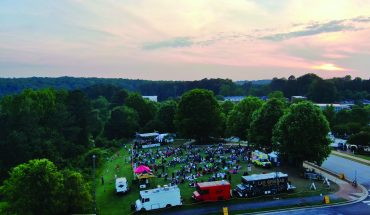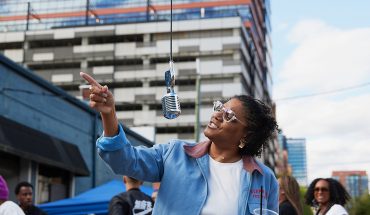by Samantha Thompson Hatem
photographs by Tim Lytvinenko
Diana Bloomfield doesn’t like working in a darkroom.
For most photographers who started taking photos in the early 1980s, this might have been a career-ending problem. But for Bloomfield, a Reidsville native, that realization turned out to be career-defining.
In Bloomfield’s garage-turned-studio behind her Saint Mary’s Street home, there’s no fancy digital camera, no collection of impressive long lenses, no spacious high-tech darkroom. Instead, the majority of Bloomfield’s work comes from the simplest type of photography equipment – a pinhole camera, most often one she has made herself.
With this low-tech device – a light-proof box with film or photographic paper and a tiny pinhole instead of a lens – Bloomfield, 61, has made a name for herself. She’s racked up awards and fellowships, showed her work around the globe, and been published in photography magazines and books.
But taking the pictures is just small part of her remarkable art. What really sets Bloomfield’s photos apart is the time-consuming and often tedious effort she puts into printing them, using old-world or alternative processes including cyanotype over platinum palladium; silver hand-tinted infrared; tri-color gum bichromate; and platinum palladium.
These techniques give her photos an ethereal quality. Some look like they could have been printed 100 years ago. The result is unforgettable images, often so worked over that they don’t even resemble photographs.
“Her work has a very organic feel to it, very earthy and dreamlike,” says Melanie Craven, one the co-owners of Tilt Gallery in Scottsdale, Ariz., which represents Bloomfield and other photographers who specialize in historical techniques and alternative processes. “She has a very distinctive style. A lot of people can relate to her subject matter and how she presents it. She’s one of our top artists.”
Bloomfield’s success comes from her willingness to shun traditional rules of photography and have a little fun exploring. “I’ve always been more an intuitive type of photographer and printer,” she said. “I tend to experiment a lot and find that working intuitively, rather than following specific guidelines and rules, works well for me. Lots of ‘happy accidents’ happen when working that way, which, again, is kind of like life.”
The effort and care she takes with her photos can almost classify her as a printmaker, says Adam Cave, who sells Bloomfield’s work at his downtown Raleigh gallery, Adam Cave Fine Art. “Her work is not something that just anyone can shoot with a digital camera,” he said. “She has a very distinctive eye. Her photos don’t feel like photographs.”
Bloomfield’s love of photography happened by chance. In 1980, she was leaving an administrative job at Princeton University, and at her going-away party, her then-boss gave her a 35-millimeter camera. She admits she was a little surprised and stumped by the gesture – and the camera – but she resolved to figure out how to use it, and enrolled in a photography class.
Bloomfield quickly discovered that she not only liked photography, but she also had an eye for it. So she took another class, this time in large-format photography, a class that required some prerequisites that she didn’t have, since large-format cameras don’t have built-in light meters and sometimes require putting a hood over your head to get the right image.
“The teachers just said, ‘Here’s the camera, here’s the film.’ I struggled through, it but I figured it out,” Bloomfield said. Figuring it out, she admits, meant walking around Trenton, N.J., photographing people while simultaneously teaching herself about light, exposure and composition.
It was worth the struggle. She ended up winning a photography fellowship from the New Jersey State Council of the Arts based on the documentary photos of people who worked in Trenton.
“From the get-go, it all came so naturally to me,” she said. “It was easy to be around it people, and it was fun.”
That then-boss who gave her the camera – Peter Bloomfield – six years later became her husband. She asked him years afterward why he’d given her the camera. “He said, ‘Because you always said you wanted to take pictures,’ but I don’t ever remember saying that,” she said.
After the couple married, they moved to North Carolina, when Peter Bloomfield took at job at the statistics department at N.C. State University. Diana Bloomfield, however, felt a little lost after the move. She missed her close-knit photography community from New Jersey. She decided to go back to school, this time taking English classes at State, and eventually earning a master’s degree in creative writing and literature, another craft that she said came easily.
In 1992, the family, which now included a daughter, Annalee, moved to New York City for a sabbatical. And it was here that Diana Bloomfield picked up her camera again using a twin-lens reflex camera to create two-inch square negatives of the vivid scenes of the city, from Central Park bridges to Coney Island amusement rides. Back in North Carolina, she kept at it, continuing to take classes and exploring different ways to manipulate photos to create dream-like images, which is how she says she sees the world.
“I wanted to photograph in more of a dreamy way rather than being so literal,” she said.
The N.C. State Fair with its rides, carnies and many colorful lights was an ideal place to chase that dreamy imagine, she said. She also began experimenting with infrared film and started hand-tinting her photos.
About the same time, digital cameras started taking over. She was teaching a photography class at the N.C. State Crafts Center, and more students were coming in with complicated digital cameras, and she was dedicating more time showing students which buttons to push rather than the art of photography. “I thought, ‘I’m not having fun, and I know they can’t be,’ ” she said.
Then she had the idea to bring into class the simple pinhole camera to help them understand the mechanics of taking a photo. “Looking into a pinhole is a great way to teach people how it works,” she said. With a pinhole camera, light passes through the pinhole and projects the image upside down on film on the other side of the box.
Bloomfield ended up getting hooked on the camera, which gave her unique perspectives, in large part because of the long exposures pinhole cameras require. “With the long exposure, you get wonderful scenes of people,” she said. “It plays with time and space.”
Plus, it gave her more of that dreamlike quality she was chasing. “It seemed to do what I wanted to do with my images,” she said.
Her journey with pinhole cameras took her in new directions with her work. She discovered platinum printing and other 19th-century printing processes. She found they kept her out of the darkroom, which she already knew she didn’t like.
Today, Bloomfield continues to explore these processes, which begin with a large digital negative or in some cases, the original. Then she mixes an emulsion and brushes it on watercolor paper. Next, she develops the image. Then she layers on another negative, painstakingly re-registering it so it’s lined up and repeats the process. “You keep doing it until you get this full, rich image,” she said.
Since the processes she works with are exposed with UV light, such as the sun or a UV light box, “no traditional darkroom is necessary,” she said.
Her muse over the years has been her daughter, who is now grown and living in New York City. Through Bloomfield’s lens, you can see Annalee at the beach, on a swing at Crabtree Creek, near Thomas Sayre’s rings at the N.C. Museum of Art, inside the listening vessels at N.C. State. Their mother-daughter connection is so strong through photography, Bloomfield says they go out to work and they never even have to speak. Annalee instinctively knows how to move to give her mother the shot she needs. The result is invaluable collection of gallery-quality photos of her daughter.
Some of her other noted pieces include photos of the marsh and beach at Bald Head Island, landscapes from a trip out west, North Carolina’s kudzu fields, the midway at the N.C. State Fair and Raleigh’s Rose Garden.
Her photos range in price from $250 to $2,100, depending on size, at Adam Cave Fine Art. You also can see her photos in collections at N.C. State’s Gregg Museum, Ravenscroft School, the City of Raleigh Museum, the Bald Head Island Club and the N.C. Department of Agriculture. One of her biggest collections of photos is at Credit Suisse, which bought 44 pieces eight years ago for its Research Triangle Park offices. She also has work in the Pinhole Resource Collection in New Mexico, one of the world’s largest collections of pinhole camera images, which was recently acquired by the New Mexico History Museum.
Bloomfield also teaches workshops from her studio, an enviable remodeled space tucked behind her home. From the front, it’s just another backyard garage in Hayes Barton. For years, it was filled to capacity with the family’s old treasures. But three years ago, she asked home builder and renovator Greg Paul to turn it into a workable space. The result is a rustic yet modern two-room studio with an exposed ceiling and a barn door separating the two rooms made from the garage’s old heart-pine floors.
In here, she’s able to labor over her photos without ever having to step into a darkroom.
“I love the whole creativity of this,” she said. “It’s such a great art form.”







